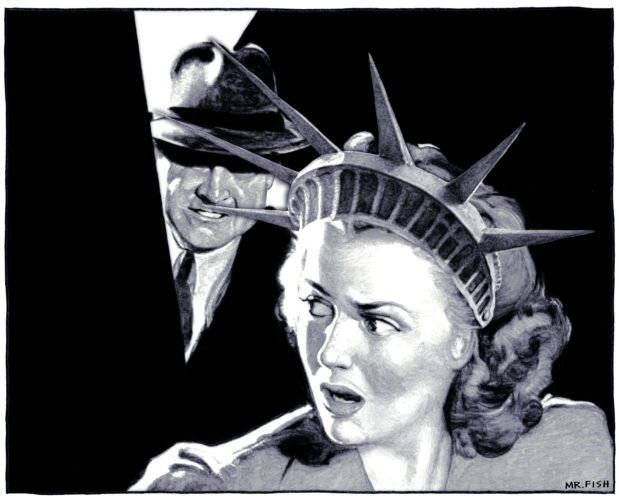Our Invisible Government
American intelligence agencies are the nation’s enemy from within and the Praetorian Guard of sinister forces. Mr. Fish / Truthdig
Mr. Fish / Truthdig
There are two forms of government in the United States. There is the visible government—the White House, Congress, the courts, state legislatures and governorships—and the invisible government, or deep state, where anonymous technocrats, intelligence operatives, generals, bankers, corporations and lobbyists manage foreign and domestic policy regardless of which political party holds a majority.
The most powerful and important organs in the invisible government are the nation’s bloated and unaccountable intelligence agencies. They are the vanguard of the invisible government. They oversee a vast “black world,” tasked with maintaining the invisible government’s lock on power. They spy on and smear domestic and foreign critics, fix elections, bribe, extort, torture, assassinate and flood the airwaves with “black propaganda.” They are impervious to the chaos and human destruction they leave in their wake. Disasters, social upheavals, economic collapses, massive suffering, death and rabid anti-American blowback have grown out of the invisible government’s overthrow of democratically elected governments in Iran, Guatemala and Chile and the wars it fostered in Vietnam, Afghanistan, Iraq, Libya and Syria. The United States and the rest of the globe would be far safer if our self-styled shadow warriors—who failed to foresee the Iranian revolution, the collapse of the Soviet Union, the 9/11 attacks or the absence of Iraqi weapons of mass destruction and whose widespread use of torture makes them the most potent recruiters for radical jihadism—were made accountable to the public and the rule of law.
There are periodic glimpses of the moral squalor and ineptitude that define this shadow world, such as those provided by the 1970s hearings led by Sen. Frank Church and the leaking of photographs of prisoners being tortured at Abu Ghraib in Iraq. But those who attempt to defy or expose the pernicious inner workings, including Edward Snowden and Julian Assange, are usually discredited, persecuted, silenced and sometimes “disappeared.” The invisible government justifies its secrecy and criminality as necessary in the face of existential threats, posed first by communism and later by Islamic terrorism. The ends always justify the means. Anything, no matter how immoral or criminal, is permissible.
The best window we have into this shadow world comes with historical accounts of its crimes, including those in Stephen Kinzer’s new book, “Poisoner in Chief: Sidney Gottlieb and the CIA Search for Mind Control.” The black sites and torture techniques pioneered by the Central Intelligence Agency in the decades after World War II—developments that saw people kidnapped, tortured and often executed—were “an indispensable link in this grim chain,” he writes.
The medical experiments carried out by the Nazis in concentration camps and the Japanese in the occupied Chinese region of Manchuria elicited two responses after World War II. There were some in the visible government who sought to hold the war criminals accountable. But there were many in the invisible government who wanted to obtain and exploit the results of these experiments and recruit the war criminals who had overseen them to work for U.S. intelligence services and the military.
The backgrounds of the Nazi scientists who had directed chemical and biological warfare projects, murdering thousands of helpless victims, including children, with agents such as the gas sarin, were sanitized by the invisible government in what became known as Operation Paperclip. No criminal, including Kurt Blome, who had overseen the Nazis’ research into biological warfare, was too heinous or sadistic for the United States to welcome and use.
“Whenever a scientist they coveted turned out to have a blemish on his record, they rewrote his biography,” Kinzer writes. “They systematically expunged references to membership in the SS, collaboration with the Gestapo, abuse of slave laborers, and experiments on human subjects. Applicants who had been rated by interrogators as ‘ardent Nazi’ were re-categorized as ‘not an ardent Nazi.’ References to their exemplary family lives were added. Once they had been thus ‘bleached,’ they became suitable candidates for Paperclip contracts.”
Shiro Ishii, who between 1936 and 1942 killed as many as 12,000 captured Chinese soldiers, anti-Japanese partisans, Koreans, Mongolians, prisoners, mental patients and, by some accounts, American prisoners of war in medical experiments on behalf of the Japanese government, was a highly valued asset to the invisible government.
Ishii oversaw a four-square-mile complex, called Unit 731, that housed 3,000 scientists and other employees. Kinzer writes that victims “were exposed to poison gas so that their lungs could later be removed and studied; slowly roasted by electricity to determine voltages needed to produce death; hung upside down to study the progress of natural choking; locked into high-pressure chambers until their eyes popped out; spun in centrifuges; infected with anthrax, syphilis, plague, cholera, and other diseases; forcibly impregnated to provide infants for vivisection; bound to stakes to be incinerated by soldiers testing flamethrowers; and slowly frozen to observe the progress of hypothermia. Air was injected into victims’ veins to provoke embolisms; animal blood was injected to see what effect it would have. Some were dissected alive, or had limbs amputated so attendants could monitor their slow deaths by bleeding and gangrene. According to a U.S. Army report that was later declassified, groups of men, women, and children were tied to stakes so that ‘their legs and buttocks were bared and exposed to shrapnel from anthrax bombs exploded yards away,’ then monitored to see how long they lived—which was never more than a week. Ishii required a constant flow of human organs, meaning a steady need for ‘logs’ [the euphemism for victims].”
After each experiment, “Ishii’s microbiologists would meticulously remove tissue samples and mount them on slides for study,” Kinzer writes. “Technicians used their research to prepare poisoned chocolate and chewing gum, as well as hairpins and fountain pens rigged with toxin-coated needles for use in close-quarters killing. In industrial-scale laboratories they bred plague-infested fleas and manufactured tons of anthrax that were placed in bomb casings and used to kill thousands of Chinese civilians.”
America’s invisible government went to great lengths to recruit Ishii and obtain the extensive records and slides from his gruesome experiments. These types of experiments would soon be replicated by the CIA in a top-secret program, MK-ULTRA, with the assistance of Ishii and an assortment of ex-Nazis.
Kinzer builds his book around Sidney Gottlieb, an elusive, quirky and powerful operative in the CIA who in his quest for mind control—something he and others in the CIA had convinced themselves the Soviets had mastered—oversaw medical experiments that had been originated by his German and Japanese collaborators. These experiments were coded-named Bluebird and later Artichoke, which Kinzer calls “one of the most violently abusive projects ever sponsored by an agency of the United States government.” The torture sessions often permanently shattered the minds of his subjects. Victims were kidnapped (later this would be called “extraordinary rendition”) and sent to clandestine centers around the globe—now known as “black sites”—or were picked from the prison population abroad and at home. Those forced into taking part in these experiments included impoverished African Americans at the Addiction Research Center in Lexington, Ky. Many of the victims were labeled “expendables,” meaning they could be murdered after the experiments and disappeared. The corpses were usually burned. Anyone who was powerless, or could be made powerless, was a potential target. Mentally handicapped children at the Walter E. Fernald State School in Massachusetts, for example, were fed cereal laced with uranium and radioactive calcium and their induced sicknesses were monitored. Gottlieb oversaw the administering of LSD and other drugs to induce psychotic states at the federal prison in Atlanta and a youth correctional facility in Bordentown, N.J. None of his subjects consented to being a human guinea pig, and many ended up psychologically impaired for life. The Boston gangster James “Whitey” Bolger, being held in the Atlanta penitentiary, was told he would be part of an experiment on curing schizophrenia but then was surreptitiously given LSD nearly every day for 15 months. CIA scientists also conducted experiments on terminally ill patients at an annex of Georgetown University Hospital in Washington, D.C.
Gottlieb searched for years for a cocktail of drugs that, in Kinzer’s words, would draw “prisoners away from their identities, induce them to reveal secrets, and perhaps even program them to commit acts against their will.” It was a vain quest. But with each failure he and the CIA became ever more zealous, working closely with former German Gen. Walter Schreiber, the onetime surgeon general of the Nazi army who had “approved experiments at the Auschwitz, Ravensbrück, and Dachau concentration camps in which inmates were frozen, injected with mescaline and other drugs, and cut open so the progress of gangrene on their bones could be monitored.” Kinzer adds that according to one American researcher, the experiments “usually resulted in a slow and agonizing death.”
Gottlieb had a habit of secretly lacing the drinks of colleagues with LSD to see their reaction. Some never recovered. One of his victims was Frank Olson, a CIA scientist who was appalled by the brutal interrogations he witnessed and planned to resign from the CIA. Gottlieb and his secretive group of torturers and assassins were terrified Olson would go public. Olson was found dead in 1953 on a sidewalk in Manhattan after allegedly diving through a hotel window. His son Eric had his father’s body exhumed in 1994 and turned over to James Starrs, a forensic pathologist at George Washington University in the District of Columbia. “Starrs had found no glass shards on the victim’s head or neck, as might be expected if he had dived through a window,” Kinzer writes. “Most intriguingly, although Olson had reportedly landed on his back, the skull above his left eye was disfigured.”
“I would venture to say that this hematoma is singular evidence of the possibility that Dr. Olson was struck a stunning blow to the head by some person or instrument prior to his exiting through the window of room 1018A,” Starrs concluded.
Starrs was later more emphatic: “I think Frank Olson was intentionally, deliberately, with malice aforethought, thrown out of that window.”
Gottlieb also oversaw the production of an array of poisons intended to be used on leaders and others deemed hostile to the United States, including Patrice Lumumba and Fidel Castro. He and the CIA pursued bizarre schemes, including finding a chemical that would make Castro’s beard fall out, leaving the Cuban leader, in the minds of CIA operatives, open to ridicule that would result in his overthrow.
The CIA also experimented with implanting electrodes in brains to control behavior. “ ‘An Agency team flew to Saigon in July 1968; among them were a neurosurgeon and a neurologist … ,’ ” Kinzer says in quoting a study of American intelligence. “ ‘In a closed-off compound at Bien Hoa Hospital, the Agency team set to work. Three Vietcong prisoners had been selected by the local station. How or why they were chosen would remain uncertain. In turn each man was anaesthetized and, after he had hinged back a flap in their skulls, the neurosurgeon implanted tiny electrodes in each brain. When the prisoners regained consciousness, the behaviorists set to work. … The prisoners were placed in a room and given knives. Pressing the control buttons on their handsets, the behaviorists tried to arouse their subjects to violence. Nothing happened. For a whole week the doctors tried to make the men attack each other. Baffled at their lack of success, the team flew back to Washington. As previously arranged in case of failure, while the physicians were still in the air the prisoners were shot by Green Beret troopers and their bodies burned.’ ”
The depth of moral squalor and criminality that can be reached by those given unlimited resources, no oversight or public accountability and total secrecy is breathtaking. Gottlieb and the CIA lured clueless victims in New York City to a “safe house” on Bedford Street and gave them drinks laced with LSD. CIA operatives directed by the thuggish George Hunter White monitored the effects.
“[White] regularly used illegal drugs, keeping for himself a share of whatever he confiscated,” Kinzer writes. “His consumption of alcohol—often a full bottle of gin with dinner—was legendary. His other appetite was sexual fetish, especially sadomasochism and high heels. He bought his second wife a closet full of boots, and patronized prostitutes who bound and whipped him. One of his few emotional bonds was with his pet canary. He loved to hold and stroke it. When the bird died, he was deeply pained. ‘Poor little bastard just couldn’t make it,’ he wrote in his diary. ‘I don’t know if I’ll ever get another bird or pet. It’s tough on everyone when they die.’ ”
White, who as a narcotics officer had hounded and often framed jazz musicians including Billie Holiday, was later moved to a safe house in San Francisco that functioned as a CIA brothel. Gottlieb, Kinzer writes, “wanted to systematize the study of how sex, especially in combination with drugs, could loosen men’s tongues.” The prostituted women were hired by the CIA to lure clients to bedrooms, decorated with photos of manacled women in black stockings and studded leather collars, and lace their drinks with LSD and other drugs.
“While his prostitutes and their clients had sex, White would watch through a one-way mirror, sitting on his portable toilet,” Kinzer writes. Gottlieb, on visits to the safe house, demanded the women have sex with him as if they were part of his personal harem.
White was given a second safe house in Marin County outside San Francisco where he used his prostituted women not only to drug men but test an array of Little-Shop-of-Horrors gadgets on his victims including stink bombs, itching powder, sneezing powder, diarrhea inducers, drug-laced swizzle sticks and aerosol cans filled with LSD.
After the long quest for a mind-control drug was abandoned, the CIA destroyed most of the records of its experiments. White, in a letter to Gottlieb thanking him for hiring him, wrote: “Where else could a red-blooded American boy lie, kill, cheat, steal, rape and pillage with the sanction and blessing of the All-Highest? Pretty good stuff, Brudder!” That would make a far more honest motto for the CIA than the biblical passage from John 8:32 carved on the walls of its original headquarters at Langley, Va.: “And ye shall know the truth and the truth shall make you free.”
Prisoners, the CIA eventually concluded, were best broken through extreme isolation and sensory deprivation. These techniques, pioneered by CIA-funded research at McGill University in Canada, were laid out in a 1964 manual titled “KUBARK Counter-Intelligence Interrogation.” KUBARK is the CIA’s cryptonym for itself. The 128-page manual was not fully declassified until 2014. It was the primary resource used by CIA interrogators in the 1960s, including in Vietnam, where at least 20,000 captured Vietnamese were killed, often after being tortured. An updated version of the manual called “Human Resources Exploitation Training Manual” came out in 1983. These forms of torture, which include shackling, sleep deprivation, electroshock, sexual and physical humiliation, prolonged cramped confinement, and hooding for disorientation and sensory deprivation, became routine after 9/11 in American intelligence black sites at home and abroad. CIA psychologists, like Gottlieb’s earlier stable of mad scientists and torturers, monitor and perfect these techniques to ensure complete psychological collapse and a childlike dependence on the interrogator.
It would be naive to relegate the behavior of Gottlieb and the CIA to the past, especially since the invisible government has once again shrouded the activities of intelligence agencies from congressional oversight or public scrutiny and installed a proponent of torture, Gina Haspel, as the head of the agency.
When an intelligence service resorts to torture, it has failed. When it relies on sadists and thugs, it has failed. When it treats human beings, including its own citizens, as unwitting pawns to be experimented upon and murdered, it has failed. When it uses dirty tricks, provides billions of dollars in weapons to renegade militias and Islamic radicals, overthrows governments and assassinates leaders, leaving in its wake mayhem and disasters it did not foresee, it has failed.
Intelligence gathering, like investigative reporting, is a process that requires immense patience, trusted sources cultivated over long periods and a cultural, historical and linguistic literacy that is the result of years of study. It is not a summer camp for creeps who revel in human degradation, dirty tricks and murder. All countries need good intelligence officials and agents, not the buffoons, gangsters, sadists and killers who, in the name of national security, do us so much damage.
Your support matters…Independent journalism is under threat and overshadowed by heavily funded mainstream media.
You can help level the playing field. Become a member.
Your tax-deductible contribution keeps us digging beneath the headlines to give you thought-provoking, investigative reporting and analysis that unearths what's really happening- without compromise.
Give today to support our courageous, independent journalists.






You need to be a supporter to comment.
There are currently no responses to this article.
Be the first to respond.